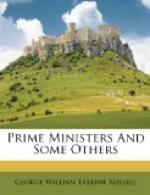In October, 1858, Charles Wood went up to Christ Church. There many of his earlier friendships were renewed and some fresh ones added: Mr. Henry Chaplin coming up from Harrow; Mr. H. L. Thompson, afterwards Vicar of St. Mary-the-Virgin, Oxford, from Westminster; and Mr. Henry Villiers, afterwards Vicar of St. Paul’s, Knightsbridge, from a private tutor’s. Charles Wood took his full share in the social life of the place, belonging both to “Loder’s” and to “Bullingdon”—institutions of high repute in the Oxford world; and being then, as now, an admirable horseman, he found his chief joy in hunting. In his vacations he visited France and Italy, and made some tours nearer home with undergraduate friends. In 1861 he took his degree, and subsequently travelled Eastward as far as Suez, and spent a winter in Rome. In 1862 he was appointed Groom of the Bedchamber to the Prince of Wales, and in this capacity attended his royal master’s wedding at St. George’s, Windsor, on the 10th of March, 1863, and spent two summers with him at Abergeldie. At the same time he became Private Secretary to his mother’s cousin, Sir George Grey, the Secretary of State for the Home Department, and retained that post until the fall of Lord Russell’s Administration in 1866.
“There was,” writes Lord Halifax, “a question of my standing for some Yorkshire constituency; but with my convictions it was not easy to come out on the Liberal side, and the project dropped. I never can remember the time when I did not feel the greatest devotion to King Charles I. and Archbishop Laud. I can recall now the services for the Restoration at Eton, when everyone used to wear an oak-leaf in his button-hole, and throw it down on the floor as the clock struck twelve.”
This may be a suitable moment for a word about Lord Halifax’s “convictions” in the sphere of religion. His parents were, like all the Whigs, sound and sturdy Protestants. They used to take their children to Church at Whitehall Chapel, probably the least ecclesiastical-looking place of worship in London; and the observances of the Parish Church at Hickleton—their country home near Doncaster—were not calculated to inspire a delight in the beauty of holiness. However, when quite a boy, Charles Wood, who had been confirmed at Eton by Bishop Wilberforce, found his way to St. Barnabas, Pimlico, then newly opened, and fell much under the influence of Mr. Bennett at St. Paul’s, Knightsbridge, and Mr. Richards, at All Saints’, Margaret Street. At Oxford he became acquainted with Dr. Pusey and the young and inspiring Liddon, and frequented the services at Merton College Chapel, where Liddon used often to officiate. By 1863 his religious opinions must have been definitely shaped; for in that year his old tutor, William Johnson, when paying a visit to Hickleton, writes as follows:
“He told me of Mr. Liddon, the saintly and learned preacher; of the devout worshippers at All Saints’, whose black nails show they are artisans; of the society formed to pray daily for the restoration of Christian unity.”




